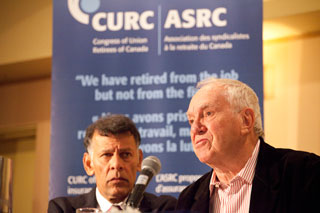Ed Broadbent on Unions and Inequality
By Ed Broadbent
Editor’s note: the following are notes for a speech by Ed Broadbent at CURC’s 11th Constitutional Convention in Ottawa, October 22, 2013.

Retired federal NDP leader Ed Broadbent, now chair of the Broadbent Institute, answers a question at CURC’s convention, Oct. 22, 2013.
CLC Secretary-Treasurer Hassan Yussuff looks on.
Thank you for the invitation to speak today on the important issue of unions and economic inequality. Any democracy worth of the name must work at achieving a high level of equality and strongly enforced rights to a union.
Last year the Broadbent Institute published two discussion papers. The first focused on the causes of rising economic inequality and what policy approaches might make a difference; the subject of the second was why it is important to maintain and increase the strength of unions and the labour movement.
The two issues are very closely related.
Starting from about 1980, we have seen a steady rise in the income share of the very top 1% in Canada, from less than 8% to a recent high of 14% before their share slipped just a bit in the Great Recession. That means that about $1 in every $7 of income in Canada now goes to the top 1%, whose incomes start at about $235,000. Not only do the rich have the greatest share of wealth they’ve had since the 1920s, since 1980 their share of the increase in incomes has been by far the greatest. In contrast, the wages of an average worker – someone in the exact middle – have remained virtually stagnant during the same period.
This is why the Occupy movement was entirely right to protest the fact that a large and rising share of all income has been going to a tiny elite, mainly consisting of top corporate executives, while middle and lower class living standards have stagnated or fallen. In a democracy, committed to the principles that everyone should have an equal chance in life, this is wrong. And it’s not the way Canada used to function.
Not at all coincidentally, the early 1980s not only marked the beginning of higher inequality. It also began the downturn in union strength. Since then, the overall unionization rate has fallen from a high of 40% to a bit over 30%, driven by a fall in private sector unionization from about 30% to under 20% today.
As union density has fallen, so has the bargaining power and political influence of the labour movement.
Unions were absolutely pivotal actors in the era of shared prosperity and growing equality which lasted from the post War period until the early 1980s. It is no exaggeration to say that unions were the principal cause of the emergent middle class. It was their militancy and organizational muscle that ensure wages kept in line with economic growth. And this was not just for their own members. Income differences narrowed considerably from the 1950s through the 1970s as the gains made by unionized workers spread to non-union workers, including in particular many in lower-paid jobs.
It is important to underline that the gains of unionization went well beyond higher wages and benefits.
Unions gave workers some power in the workplace compared to management, marking a small step towards democratic citizenship at work. Increasingly, matters that had always been seen as “management prerogatives” came up for bargaining.
Unions also became important political actors, working through political parties, especially but not exclusively the CCF and NDP, to advance public pensions, public health care, unemployment insurance, affordable housing, widely accessible post secondary education and other key building blocks of what came to be called the welfare state. Indeed, in 1960 the labour movement was one of the founding partners in the creation of the NDP.
It was through political action that union rights – the right to union recognition, the right to free collective bargaining and the right to strike – were entrenched in all of the key human rights conventions of the post War period, were ratified by Canada with the consent of the provinces, and became rightly seen as integral to the very idea of democracy.
A strong and progressive labour movement promotes greater equality in two important ways.
First, unions directly narrow pay differences and reduce the proportion of low paid jobs—hence more equality in incomes.
Second, the labour movement has supported economic and social rights (pensions, health care, education) for all workers. They have promoted public services that provide benefits to citizens paid for through progressive taxes, so access to them doesn’t depend on personal income—hence more equality again.
Social democrats understand that it is hard to redistribute income to achieve greater equality if income earned from the market is highly unequal to begin with.
Countries like Sweden are much more equal than Canada, not just because of higher levels of social spending, but also because the labour movement has represented the vast majority of employees and has deliberately tried to narrow wage and salary differences.
Strong labour movements have also taken the lead in bargaining for pay equity for women and racialized groups, thus again serving the democratic cause of greater equality.
Political scientists have long recognized that a major reason why the Canadian labour movement remains stronger than the US labour movement is our stronger tradition of social unionism, the belief that unions have to speak for and fight for the interests and concerns of all workers not just in the workplace, but also, as I have emphasized, in the political sphere. The truth is that the NDP here in Canada has supported labour rights much more consistently than has the Democratic Party in the USA.
Challenges
The Canadian labour faces some fundamental challenges today, including falling union density and an overt attack on union rights by right-wing governments at both federal and provincial levels.
In countering this attack, it is vital that unions build membership and bargaining power among workers, especially among the many lower-paid and insecure workers in the private service sector who lack access to the benefits and protections of unionization.
While this is a daunting challenge, it is encouraging to see that the Canadian Labour Congress and the new union, Unifor, are prepared to take it on.
It is also encouraging that the labour movement continues to campaign for the interests of all working people in the political domain, as in the current fight for better public pensions and higher minimum wages. Again, both are essential to building a more equal Canada.
A strong and progressive labour movement was crucial to the creation of the middle-class in Canada in the first place. Rebuilding the movement will be equally pivotal to the major task of reversing the trend to greater inequality today. We need both a more equal Canada and strong unions. They go hand in hand.








